TENS units are widely used for different conditions. But, can you use it for common injuries that happen at work or while exercising?
TENS units are good for sprains, especially when used in combination with other forms of treatment like massage, RICE, cold and hot packs, etc. With proper pad placement, settings, and additional therapies, a TENS unit can help you when it comes to sprain-related pain relief.
TENS is a useful little device that has some support in research, but more is needed. However, because the side effects of it are so rare and it won’t cause any harm, you can try it for sprains. To learn more about this — and how to use TENS for sprains — read on.
TENS Pad Placement for an Ankle Sprain
Ankle sprains are pretty common and a TENS unit is a great way to help alleviate pain, reduce inflammation and help the healing process.
When placing the electrode pads it is best to surround the pain area. Place one electrode pad on your ankle and the other below the calf area.
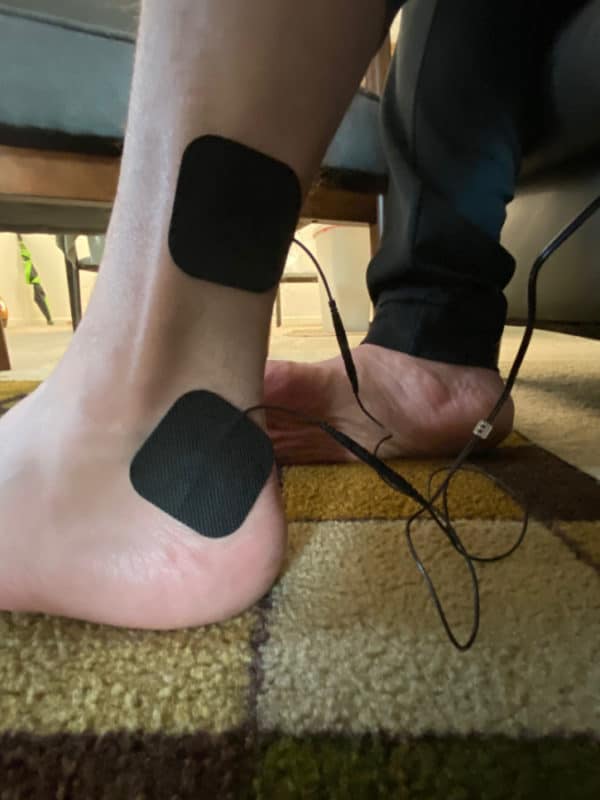
About TENS
TENS is a form of therapy for pain that uses electrical impulses to block pain signals and improve the natural production of endorphins and other chemicals in our body in charge of dealing with pain.
It’s a small device, and it’s very portable, so people can use it anywhere. It usually has two to eight electrodes, depending on the type of the device, and they have adhesive pads at the ends, which help keep them attached to your skin.
The sensation from TENS is a pleasant one, and it shouldn’t be painful. If it is painful or uncomfortable, you should switch to milder settings. They range from different high frequencies and intensities to low ones, and some even have the option of a massage.
They are also inexpensive, so you can get one cheaply and get a lot of use from it.
TENS is generally recommended for:
- Arthritis
- Injuries due to work and sport
- Period or labor pain
- Back or neck pain
- Shoulder pain
- Tennis elbow or frozen shoulder
Research on TENS is still limited, but some studies are promising, and they state that TENS might work for certain conditions. Of course, more research is needed in this area, but it doesn’t hurt to try since TENS has no side-effects.
The only issues that you may encounter are:
- If your skin gets irritated with regular adhesive pads, you can buy hypoallergenic ones and use them instead.
- If you keep in on one spot for too long, your skin could get irritated, and that area might start to hurt, which is why it’s recommended to move it around every 20 minutes.
- If you have one of the conditions where TENS is not recommended — if you have any metal or electronic devices in your body (like a pacemaker), if you have epilepsy, if you are pregnant and use TENS on your abdomen or lower back, etc.
- If you use TENS on your eyes or on the front part of your neck
However, all of these issues can be avoided by simply following the guidelines that will come with your device. You also shouldn’t use TENS while driving, while near water, or when sleeping. You shouldn’t overuse it because then you might feel more pain, and you shouldn’t use it at an intensity higher than what’s comfortable for the same reason.
Before purchasing a TENS unit, you can talk to your doctor and see if they think that it’s a good idea. Most doctors recommend it for pain, but your health condition may not allow it. Carefully consider whether you should use it.
If you want to check if it will work for you, you can rent one or get one from a friend so you can try and see how it feels. If it helps you, you can easily purchase one without a prescription. It’s not addictive, and it’s not invasive, so there’s no way that you can get addicted to it, unlike with pain killers.
The pads should never be placed on your mouth either, on open wounds or areas that have been damaged in any way, on varicose veins or tissue that is numb. You should experiment with different settings before arriving at one that gives you the most relief. Some research states that higher frequencies create pain-relief that lasts longer, but you shouldn’t do anything that doesn’t feel good to you.
It’s a good idea to start using a TENS machine at a low setting and then gradually increase the intensity so that you can adapt yourself to the feeling.
The skin beneath the electrodes should be clean and dry before you place electrodes on. You should use the conductor gel as well. After using TENS, shut the machine off and clean the area again.
Need a TENS Unit?
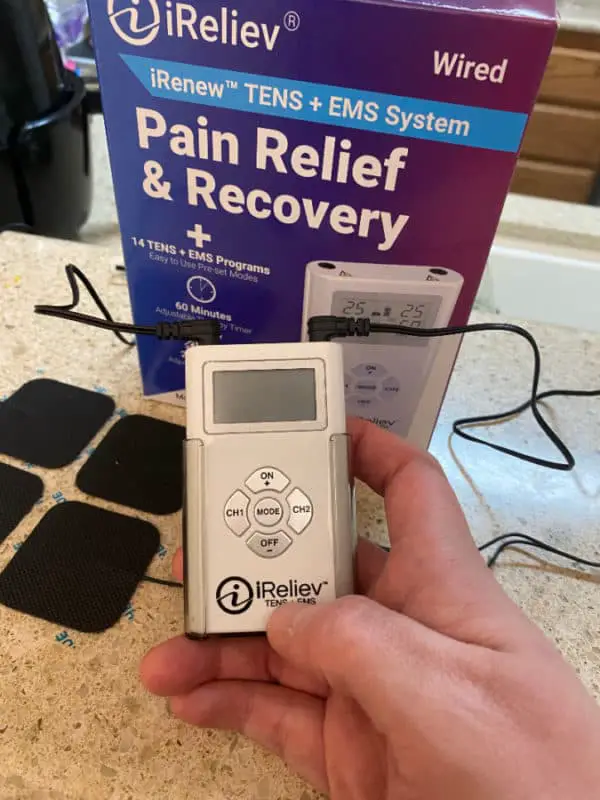 This is the exact TENS unit that I use. It is perfect for alleviating many common types of pain.The iReliev is a great little device and has a lot going for it. It is well under $80 and has several programs to choose from and is small enough to fit in your pocket.
This is the exact TENS unit that I use. It is perfect for alleviating many common types of pain.The iReliev is a great little device and has a lot going for it. It is well under $80 and has several programs to choose from and is small enough to fit in your pocket.
You do not need to spend hundreds of dollars to get a quality TENS unit and iReliev gives you a ton of value for the price being paid. Best part is they are based in Dallas, Texas and have phenomenal customer service FREE shipping and delivery in less than 5 days.
Get yours today on the iReliev website by clicking here.
About Sprains
Commonly, sprains happen in the ankle because of some movement tears or stretch the ligaments too much. The most common treatment for sprains is the RICE therapy, which means that you have to rest your ankle, put some ice on it, compress it, and elevate it. Most people don’t get any specific treatment for ankle sprains, and they live through it at home.
However, ankle sprains can get serious too. Sometimes, you might even need surgery.
People commonly use the terms sprains and strains interchangeably, but they are not the same thing. A sprain means that the ligaments between bones are harmed, while a strain means hurting your muscles or the tissue that connects the bone and the muscle. While quite similar in name, they are different. So, you have to determine which one happened before you can apply any treatments.
There are several symptoms that can help you identify a sprain. While they may vary from person to person and based on the severity of the injury, they will most likely involve:
- Pain
- Bruising
- Limited range of motion without pain
- Swelling
- A popping sound
You can treat most sprains at home without visiting a doctor. However, sprains can prove dangerous in some cases, with more serious injuries, so you should watch out for these symptoms:
- If you can’t move your ankle or you can’t carry weight on that joint
- If your pain is located directly on the bone
- If that area is numb
- If the swelling is only growing
If you get any of these symptoms, you should go to see a doctor immediately.
Sprains happen because of some sort of stress on the joint. They can be in the ankle, which is the most common kind, and it happens if you land improperly after a jump, or if you step on something uneven. A sprain can also happen in the knee if you pivot while exercising. It can be in your wrists, too, if you land on your hands. Finally, sprains can also happen in your thumb, but it’s more common in people playing tennis.
So, if you’re near slippery terrain or an uneven one, you are more likely to get a sprain. You can also get a sprain if you are tired, especially if you exercise while tired. If you have bad equipment for exercising or bad shoes, it could make sprains more likely as well.
You can prevent sprains by stretching more often, especially before an activity. You can also get a brace for the area where you get sprains.
Usual Treatments for Sprains
In general, treatments for sprains are very simple, and you can do them at home. The most important thing to do is to control the swelling. If you have any braces, bracelets, rings, or anything similar around your injured joint, remove them immediately, and then perform the RICE treatment.
If you still have some pain after 48 hours of doing the RICE method, you should contact your doctor and ask them about a possible solution. They might give you some medication that will stop the pain. Instead of painkillers, you can also use TENS at this point, or even sooner.
Research On TENS and Sprains
The research on TENS for different conditions is generally limited, but the studies that exist are generally positive.
One study tested TENS for the purposes of helping increase the range of motion in ankle sprains, and it confirmed that TENS could be effective for these purposes. Another study found that combining exercise and TENs after an injury can help speed up the recovery. The same study found that the recovery was slower without TENS.
A study also found that exercise can be improved after an ankle sprain and that instability can be decreased if a subject uses TENS. Research published in Physical Therapy stated that TENS while helping with pain, may not be as good for reducing the swelling immediately after an ankle sprain or a similar injury.
TENS can also improve the walking possibilities after an injury like a sprain and give an analgesic effect, as found by another research.
Benefits of TENS for Sprains
TENS units have numerous benefits for sprains, no matter where they are. Let’s take a look at some of the most common benefits of TENS units.
- Pain Relief. This is the biggest advantage of using TENS. It will stimulate your nerves and allow you to reduce the feelings of pain, both acute and chronic. No matter the location of the pain, TENS can reach it and help you relax.
- It’s non-invasive. Another big perk of TENS is that it’s non-invasive, meaning that it won’t take an expert to treat you with this device. You won’t be harmed in any way, especially if you use it according to the guidelines.
- Efficient. A TENS unit will cause immediate pain relief, and it will work well with other treatments as well. It works for many different conditions, and ankle sprains, as some of the studies have shown, can be treated with it as well.
- Portable. These devices are small — some smaller than smartphones — and quite discreet, so you’ll be able to use it on the go if you need to, and no one will probably notice.
- Easy to use. TENS is very simple to use. All you have to do is attach the pads to the affected area and use the mode that suits you. You can also manually set it up, so you get the most benefits during your healing.
- Better blood flow. TENS will also speed up your circulation and make your blood flow faster and more to the muscles, especially in the area where the pain is. This supports the healing process and reduces pain too.
- Better sleep. If you have less pain than usual, it will be easier for you to fall asleep. Pain makes it hard to relax, and ankles take a while to heal before the pain stops. So, it’s beneficial to have something that can provide relaxation for long enough to forget about the pain.
- Better range of movement. TENS can also improve your range of motion after an injury, as proven by some studies above. It’s relaxing, and it will make exercise after injury easier. It can speed up the recovery process and bring you back in shape more quickly than other forms of therapy.
- It’s a massager. TENS is both a pain relief treatment and massage treatment. Most companies sell TENS devices with both capabilities, and you can rely on it to give you an excellent treatment after a hard day of workout or activity.
- TENS can retrain nerves. In addition to reducing pain, TENS might also be able to retain some of your nerves, especially ones suffering from nerve damage. It will also reduce the pain signals coming to your brain.
- Reducing inflammation. TENS is also famous for reducing inflammation, which could be one of the biggest sources of pain and discomfort. So, you can rely on it to help your muscles and tissue in returning back to normal.
- Quicker process of healing. Being in pain is not comfortable, and daily actions can be hard with pain. However, when TENS reduces pain, you’ll be able to perform some movements that may help speed up your process of healing. The fear of pain could also be preventing you from healing, so you might want to use TENS to reduce that fear.
- It’s affordable. TENS is one of the easiest and most inexpensive therapy tools you can get on the market. Unlike many other expensive gadgets, this one will come in cheap, even with some of the best brands.
- No medication needed. Medication can be addictive, but TENS is not, so you can reduce your dependence on painkillers by replacing them with a TENS unit. Both acute and chronic pain patients can rely on it to help them with pain with no side effects and no need for drugs.
- No negative effects. With TENS, negative effects are very rare. The only cases where they do happen is if the user hasn’t followed the instructions correctly, but even then, the side effects are mild. So, you can relax knowing that you won’t be harmed by a device meant to help you with pain.
As you can see, there are plenty of benefits to using a TENS unit for your pain. Make sure that you are using it according to the guidelines, and you shouldn’t have any issues.
Want to know where a TENS unit can be placed? Check out my TENS placement guide here. Below are a few common TENS electrode pad placements:
Combination Therapy With TENS for Sprains
One of the biggest benefits of TENS is that it works so well with other common types of therapy. The most recommended combination is TENS and ice. You are likely familiar with the RICE method of pain relief — rest, ice, compress, and elevate.
While ice is beneficial for pain relief, you can’t use it all the time. You have to take breaks. But pain doesn’t take breaks, so you might want something to relieve your pain in the meantime. TENS is a great solution, especially since some studies have shown that TENS in combination with ice can help prolong the pain relief.
Of course, you can’t use them at the same time, but interchangeably, which also works. Both TENS and ice have the ability to reduce inflammation and swelling, which is excellent for those first 72 hours after an injury.
Another commonly recommended form of therapy is a mix of TENS and moist heat. Moist heat is beneficial for pain, but it’s even better for improvement of the range of motion of joints. So, after your pain reduces a bit and your swelling is under control, you can combine moist heat and TENS interchangeably to improve the movement of your ankle.
Furthermore, you can use TENS with massage therapy and exercise, especially right after using TENS. TENS can prepare the body for the movement — whether exercise or massage — and allow you to improve your state with more ease.
Conclusion
TENS relieves both acute and chronic pain, so sprains shouldn’t be an issue, especially so if you combine this nifty little device with other forms of therapy. For example, using ice on your ankle for a while and then during breaks between ice packs, you can use TENS. This extends pain relief.
Furthermore, TENS can provide a gentle massage that can also help you relax. Keep in mind that you should ask your doctor about it and also follow the guidelines that will come with the product.
Sources
- NCBI: Effect of exercise therapy combining electrical therapy and balance training on functional instability resulting from an ankle sprain—focus on the stability of jump landing
- NCBI: The effect of adding TENS to stretch on the improvement of ankle range of motion in inactive patients in intensive care units: a pilot trial
- ResearchGate: Electrical stimulation as a treatment intervention to improve function, edema or pain following acute lateral ankle sprains: A systematic review
- ResearchGate: The Effects of Transcutaneous Electrical Nerve Stimulation on Functional Instability due to Ankle Sprain: Electrotherapy during Exercise on an Unstable Plate
- Oxford Academic: Effect of Neuromuscular Electrical Stimulation on Ankle Swelling in the Early Period After Ankle Sprain
- KoreaMed: The Effect of 2 Hz and 100 Hz Electrical Stimulation of Acupoint on Ankle Sprain in Rats
- NCBI: Using TENS for pain control: the state of the evidence
- NCBI: Effectiveness of Transcutaneous Electrical Nerve Stimulation for Treatment of Hyperalgesia and Pain
- PubMed: Effect of Transcutaneous Electrical Nerve Stimulation on Human Blood Beta-Endorphin Levels
- Sage Journals: Prevention of ankle sprains
- American Family Physician: Management of Ankle Sprains
- Harvard University: Recovering from an ankle sprain

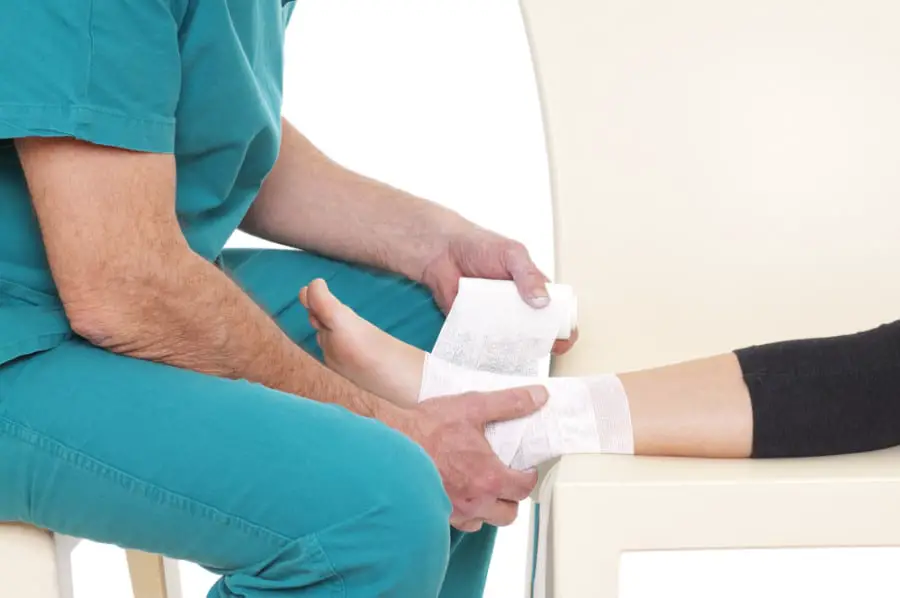
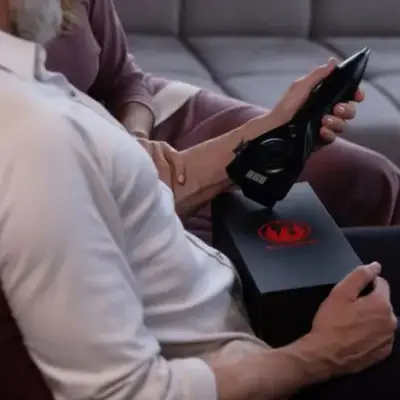

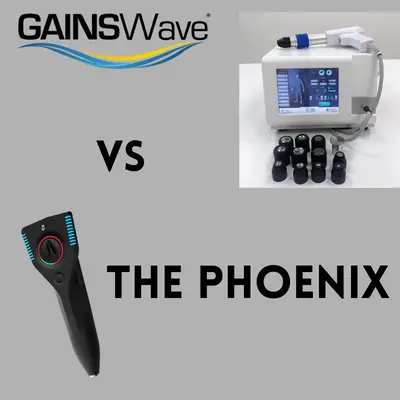
4 responses to “Is a TENS Unit Good for Sprains?”
[…] there is also another option available, which is using a TENS unit. A TENS unit is a device that uses electrical stimulation to relieve […]
[…] apart from one another. Feel free to move the pad if it is not in the right place. When placing the TENS unit pads you should NEVER put them over your knee […]
[…] a small, handheld electronic device that consists of several components. Still, no matter how a TENS unit looks or what its exact features happen to be, its purpose remains the same: Relieving muscle […]
[…] TENS control unit is what emits electrical signals to the electrode pads. It is also what users access […]